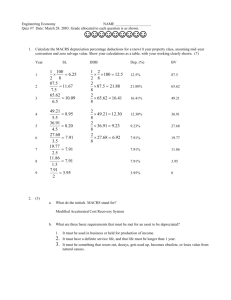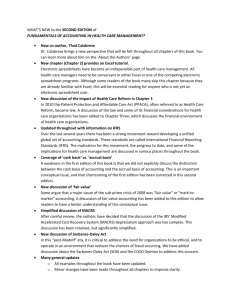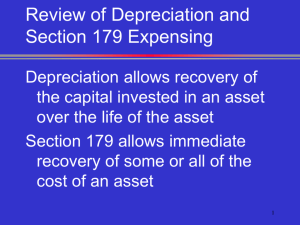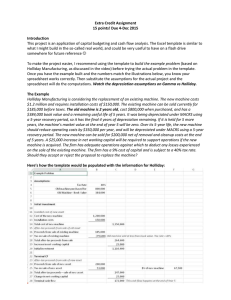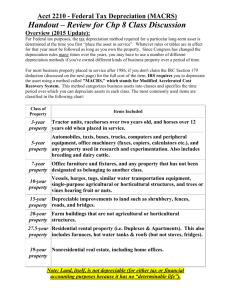Sample Problems—Capital Budgeting—part 2
advertisement
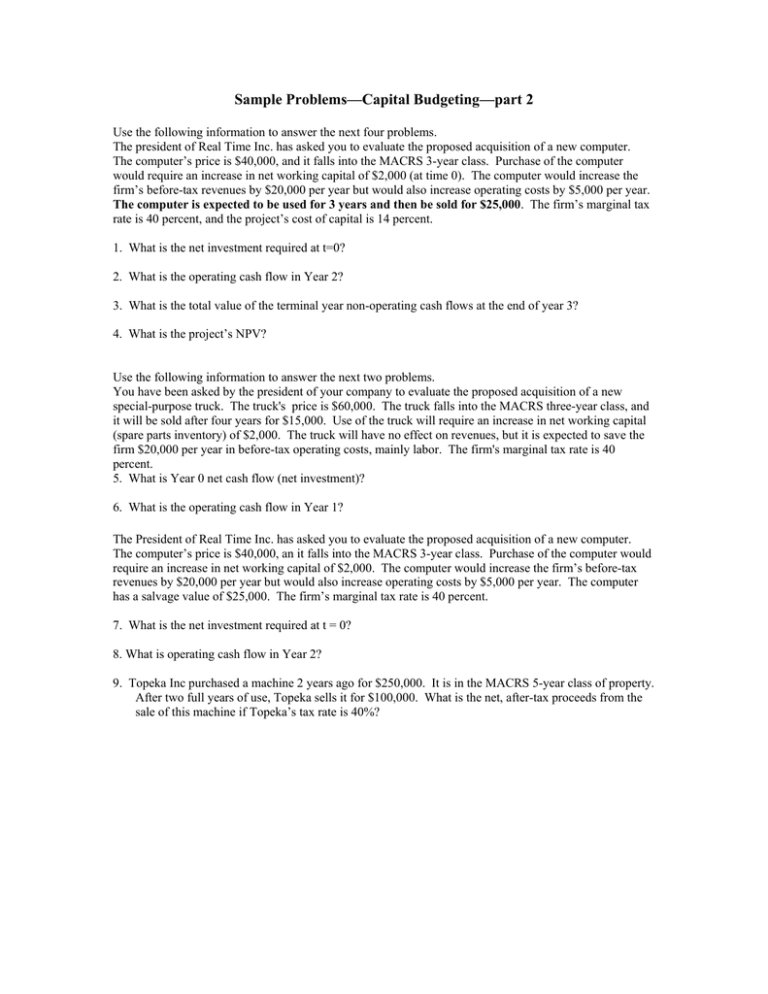
Sample Problems—Capital Budgeting—part 2 Use the following information to answer the next four problems. The president of Real Time Inc. has asked you to evaluate the proposed acquisition of a new computer. The computer’s price is $40,000, and it falls into the MACRS 3-year class. Purchase of the computer would require an increase in net working capital of $2,000 (at time 0). The computer would increase the firm’s before-tax revenues by $20,000 per year but would also increase operating costs by $5,000 per year. The computer is expected to be used for 3 years and then be sold for $25,000. The firm’s marginal tax rate is 40 percent, and the project’s cost of capital is 14 percent. 1. What is the net investment required at t=0? 2. What is the operating cash flow in Year 2? 3. What is the total value of the terminal year non-operating cash flows at the end of year 3? 4. What is the project’s NPV? Use the following information to answer the next two problems. You have been asked by the president of your company to evaluate the proposed acquisition of a new special-purpose truck. The truck's price is $60,000. The truck falls into the MACRS three-year class, and it will be sold after four years for $15,000. Use of the truck will require an increase in net working capital (spare parts inventory) of $2,000. The truck will have no effect on revenues, but it is expected to save the firm $20,000 per year in before-tax operating costs, mainly labor. The firm's marginal tax rate is 40 percent. 5. What is Year 0 net cash flow (net investment)? 6. What is the operating cash flow in Year 1? The President of Real Time Inc. has asked you to evaluate the proposed acquisition of a new computer. The computer’s price is $40,000, an it falls into the MACRS 3-year class. Purchase of the computer would require an increase in net working capital of $2,000. The computer would increase the firm’s before-tax revenues by $20,000 per year but would also increase operating costs by $5,000 per year. The computer has a salvage value of $25,000. The firm’s marginal tax rate is 40 percent. 7. What is the net investment required at t = 0? 8. What is operating cash flow in Year 2? 9. Topeka Inc purchased a machine 2 years ago for $250,000. It is in the MACRS 5-year class of property. After two full years of use, Topeka sells it for $100,000. What is the net, after-tax proceeds from the sale of this machine if Topeka’s tax rate is 40%? Use the following information to answer the next 3 questions. The president of your company has asked you to evaluate the proposed acquisition of a spectrometer for the firm's R&D department. The computer’s price is $170,000, The spectrometer falls into the MACRS 3-year class and would be sold after 3 years for $60,000. Purchase of the spectrometer would require an increase in net working capital of $8,000. The spectrometer would have no effect on revenues but is expected to save the firm $50,000 per year in before-tax operating costs, mainly labor. The firm’s marginal tax rate is 40 percent. 10. What is the initial outlay in year 0 associated with this project? 11. What is the incremental operating cash flow in Year 1? 12. What is the terminal cash flow in Year 3? Use the following information to answer the next two questions. Stanton Inc. is considering the purchase of a new machine which will reduce manufacturing costs by $5,000 annually and increase revenues by $6,000 annually. Stanton will use the MACRS method to depreciate the machine, and it expects to sell the machine at the end of its 5-year operating life for $10,000. Stanton’s marginal tax rate is 40 percent and it uses a 9 percent cost of capital to evaluate projects of this type. The machine’s cost is $40,000. 13. What is the operating cash flow in Year 2? Ownership Year 1 2 3 4 5 6 Class of Investment 3-Year 5-Year 33% 20% 45 32 15 19 7 12 11 6 14. What is the terminal year non-operating cash flow at the end of year 5? Clinton Carbide, Inc., is considering a new three-year expansion project that requires equipment that costs $1.5 million. Clinton will have to pay another $300,000 to modify the equipment for their use. The equipment falls into the three-year MACRS class and will be sold for $325,000 at the end of year 3. It is estimated that the project will generate $1,850,000 in annual sales, with operating costs of $650,000. Additionally, the project requires an investment in net working capital of $275,000 at time 0. Clinton’s tax rate is 35 percent and the firm has a 12% cost of capital 15. What is the net investment required at t=0? 16. What is the operating cash flow for year 2? 17. What is the total value of the terminal year’s nonoperating cash flow at the end of year 3? 18. Dogs Up! Franks is looking at a new sausage system with an installed cost of $400,000. This cost will be depreciated straight-line to zero over the project’s five-year life, at the end of which the sausage system will be worthless. The sausage system will save the firm $150,000 per year in pretax operating costs. If the tax rate is 34 percent and the cost of capital is 10 percent, what is the NPV of this project? 19. Kaleb’s Korndogs is looking at a new sausage system with an installed cost of $460,000. This cost will be depreciated straight-line to zero over the projects five-year life, at the end of which the sausage system can be scrapped for $40,000. The sausage system will save the firm $118,000 per year in pretax operating costs. The tax rate is 40 percent. What are the operating cash flows in years 1-5? Use the following information to answer the next 3 questions: The president of Harris Company is evaluating the proposed acquisition of a new milling machine. The machine’s installed price is $120,500. The machine falls into the MACRS 3-year class, and is expected to be used for 3 years and then be sold for $65,000. The machine would require an increase in net working capital of $5,500 at time 0. The milling machine is expected to increase revenues by $88,000 but to also increase operating costs by $44,000. The firm’s marginal tax rate is 40 percent, and the project’s cost of capital is 12 percent. 20. What is the operating cash flow in Year 2? 21. What is the total value of the terminal year non-operating cash flows at the end of year 3? 22. If the time 0 cash flow is -$126,000 and the operating cash flows in years 1 and three are $42,306 and $33,630, respectively. What is the project’s NPV? You have been asked by the president of the Farr Construction Company to evaluate the proposed acquisition of a new earth mover. The mover’s basic price is $50,000, and it would cost another $10,000 to modify it for special use. Assume that the mover falls into the MACRS 3-year class, it would be sold after 3 years for $20,000, and it would require an increase in net working capital (spare parts inventory) at time 0 of $2,000. The earth mover would have no effect on revenues, but it is expected to save the firm $20,000 per year in before-tax operating costs, mainly labor. The firm’s tax rate is 40 percent. 23. What is the operating cash flow in year 2? 24. What is the terminal cash flow? 25. Calculate the NPV of purchasing the earth mover if the project’s cost of capital is 10 percent. 26. A project costs $50,000, will be depreciated straight-line to zero over its 3-year life, and will require a net working capital investment of $10,000 up-front. The project generates operating cash flows of $30,000 per year. The fixed assets will be sold for $8,000 at the end of the project. If the firm has a tax rate of 35% and a cost of capital of 12%, what is the project NPV? Harris Company is evaluating the proposed acquisition of a new milling machine. The machine’s price is $120,000 and it falls into the MACRS 3-year class. Use of the milling machine would increase revenues by $100,000 per year and increase before-tax operating costs by $60,000 per year. Harris expects to use the machine for four years and then sell it for $10,000. Harris’s tax rate is 40 percent and cost of capital is 12%. 27. What is Year 2’s operating cash flow? 28. What is the terminal cash flow? 29. If the time 0 cash flow is -$120,000 and the operating cash flows for years 1, 3, and 4 are $39,840, $31,200, and $27,360, respectively, what is the NPV of the milling machine? 30. Amstead Inc. is planning on depreciating new machinery that costs $300 million as a 5-year MACRS property. The project for which the machinery is being purchased ends in four years, and as a result the machinery is going to be sold at its salvage value of $50 million. Under this accelerated depreciation method, what is the after-tax cash flow expected to be generated by the sale of the equipment in Year 4? Assume the tax rate is 40 percent. Use the following information to answer the next two questions Mills Mining is considering an expansion project. The project has an initial cost of $500,000 and can be depreciated under the MACRS system as a 3-year property. If the project is undertaken, inventories will rise by $50,000, while accounts payable will go up by $10,000. The project is expected to operate for 4 years, at which time it will be terminated. The cash inflows are assumed to begin 1 year after the project is undertaken and continue out to t=4. At the end of the project’s life (t=4), the equipment is expected to have a salvage value of $50,000. If the project is undertaken, the company will realize an additional $600,000 in sales over each of the next four years and the operating costs will equal $400,000 per year. Mill’s Mining’s tax rate is 40 percent and its WACC is 10 percent. 31. What is the project’s free cash flow in year 4? 32. Refer to the above problem, calculate the project’s NPV. The Free Cash Flows for years 0 through 3 are as follows: Year 0 1 2 3 Free Cash Flow -$540,000 186,000 210,000 150,000 33. The Fernandez Company has the opportunity to invest in one of two mutually exclusive machines that will produce a product it will need for the foreseeable future. Machine A costs $10 million but realizes free cash flows of $4 million per year for 4 years. After 4 years, the machine must be replaced. Machine B costs $15 million and realizes free cash flows of $3.5 million per year for 8 years, after which it must be replaced. Assume that machine prices are not expected to rise because inflation will be offset by cheaper components used in the machines. If the cost of capital is 10 percent, which machine should the company use? (Do not simply state Machine A or Machine B….show your work.)
